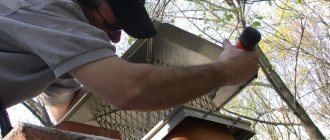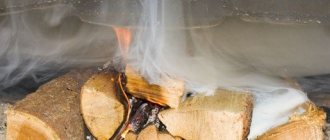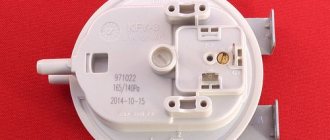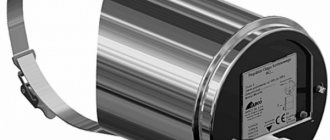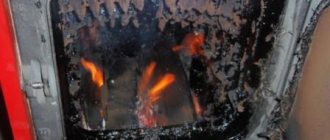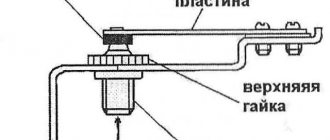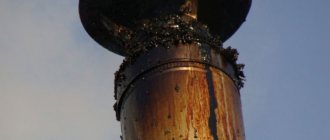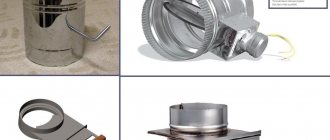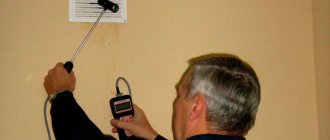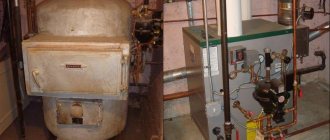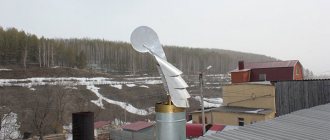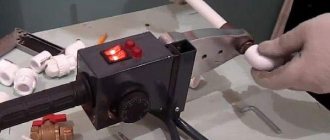How to make a chimney damper with your own hands
It is better to make and install a damper yourself during the process of laying a fireplace or installing a metal chimney.
To make a simple retractable damper, sheets of galvanized or stainless steel with a thickness of 2-2.5 mm are required. Making guides around the perimeter of the chimney will require 6 mm thick wire.
To complete the work you need equipment and tools:
- grinder or metal scissors;
- grinding disc for angle grinders;
- drills and files for metal;
- marker for marking.
It is advisable to do all the work on a special lathe or typesetting machine. If the shape of the chimney is rectangular, you can make the simplest gate damper by simply cutting a piece of sheet steel of the required size. It is recommended to weld the handle or drill a small hole for ease of adjustment of the gate.
Before starting work, we measure the area and cross-sectional shape of the chimney, and use a marker to make marks on a sheet of cardboard in accordance with them. To make the frame, we bend the wire in the shape of the letter P, the width and length coinciding with the cross-section of the chimney. Using a grinder, we cut out the flap using a cardboard template, and sand the edges with a sanding disc.
Making a butterfly valve requires more tools and time. Most often this type of damper is used for metal chimneys for modern fireplaces and metal freestanding stoves.
Set of tools for work:
- Bulgarian;
- drill;
- pliers;
- welding machine;
- compass;
- roulette;
- marker for marking.
- First, measure the internal diameter of the chimney pipe using a compass.
- According to it, draw a circle on sheet steel.
- Use a grinder to cut out a circle.
- Place the cut fragment into the pipe and check the tightness of the fit. If necessary, rework the valve with a grinding disc.
- Place a metal tube with a diameter of 6 cm on the circle in the center and make marks on it, retreating 3 mm from each side of the circle.
- Cut off the tube with a grinder.
- In the resulting pipe section, drill the threads to 6.8 mm on both sides.
- Drill holes in the steel circle for welding (one in the center, two 1 cm from the edge on opposite sides).
- Weld the threaded tube to the steel circle.
The slide valve is ready, all that remains is to install it in the chimney pipe.
You can install a damper for a fireplace or heating unit in one of three ways:
- The damper is installed directly in the fireplace insert. It is placed at a distance of 100 centimeters from the heating device, which makes it easy to control.
- Combining the damper with other elements of the heating structure without the use of additional fasteners. This installation method is called “pipe to pipe”.
- The damper is installed in ventilation pipes. It is used to prevent the fan motor from overheating during operation.
Installation must be carried out in the closed position of the gate to prevent excess load on the engine.
Since there are a variety of models of stove units and fireplaces and heating using them is carried out in different ways, each of them requires its own type of valve.
For example, for a stove operating on gas, you will need a classic rotary-type throttle valve or a rotary automatic damper, since they are capable of blocking the chimney pipe completely and then the flame will not be able to escape outside.
At the same time, rotary valves should not be installed when installing a sauna stove, since when closed they will allow steam to pass through, and in the open position they are very difficult to clean.
As a rule, a damper for a fireplace or stove unit is sold as a complete set along with a chimney. But there are smoke exhaust structures without a damper, so you can make one yourself by buying elements for it at a hardware store. The main thing to do before purchasing them is to decide on the required sizes.
Fire safety rules for installing and using a potbelly stove
Compliance with fire safety rules when using a potbelly stove will protect all residents from possible unpleasant consequences:
- The fuel must be dry only; flammable mixtures must not be used;
- ignition is carried out by slightly opening the combustion damper, adding the required amount of combustible material and, directly, ignition;
- sufficient combustion of the fuel makes it possible to regulate the power level of the furnace device by closing or opening the ash compartment;
- Cleaning the furnace from accumulation of ash is carried out when the body has completely cooled, by pulling out the ash drawer and throwing out the contents.
We recommend that you familiarize yourself with the material on our website: “How to make potbelly stoves for a bath yourself.”
- the first use of a potbelly stove will be accompanied by the smell of melting paint, but in the future this episode will not occur;
- things that have a highly flammable composition should be located at a distance of 1 m from the stove;
- within one load, you cannot put more than 3 kg of dry fuel into the combustion compartment, while the door must be closed;
- It is strictly prohibited to use a potbelly stove when detecting any malfunctions in the operation of the chimney;
- Leaving a heater in working condition unattended with children present in the room is prohibited;
- during operation, the body of the potbelly stove becomes very hot, so you cannot touch it;
- The installation of the stove structure is carried out only on a special base (pedestal) with non-flammable properties.
Modern means for improving chimney draft
Now we will tell you how to increase draft in a chimney using modern technical devices that can be purchased in specialized stores. We will consider each device separately so that you can choose the one that is most suitable for you in terms of parameters and quality.
The most well-known means is a chimney draft regulator. This device is designed for installation on the chimney outlet. After making the adjustment, the product compensates the pressure in the pipe with external pressure, due to which both the normalization of the operation of heating devices and the normalization of traction speed occur
By the way, this device has one important advantage - its installation leads to an increase in the efficiency of the heating system
The second device is a deflector, which is also installed on the outer part of the chimney. The main difference of this device is that the outer diameter of the deflector is much larger than the cross-section of the chimney, resulting in the effect of a drop in pressure level. Thus, when an air flow flows around the structure of the device, a low pressure area is created inside the device. This contributes to the emergence of all the conditions for increasing and normalizing the thrust speed.
You can use a chimney weather vane - a device that not only improves the rate of gas removal, but also protects the pipe from rain and small debris from the street. The basis of such a weather vane is the deflector principle, and the gas is discharged only from the leeward side, due to which the level of external air resistance can be reduced. Due to this, the thrust speed is normalized. You can also install a smoke fan, which is considered one of the most effective methods. A ventilation system is installed inside the chimney draft amplifier, which artificially creates an air flow inside the pipe. The main feature of this device is the need to connect an electrical line.
There is also a special chimney draft stabilizer, with which you can exercise complete control of the air flow in the pipe. It is possible to install a sensor under the device hood to record the temperature of the rising gas. If the traction speed deteriorates, a special thermal sensor will operate.
Top reasons for lack of traction
It is necessary to determine the time frame for the occurrence of the malfunction. Separately, it is worth considering cases when the chimney is new and during a test run the fact of reverse draft is revealed. Let us consider the reasons separately and in detail.
Reason 1. Incorrect chimney.
Proper chimney design is important for good air movement. If there is no draft when checking a new heating structure, then the reason is one or a combination of errors:
- The pipe diameter is too small and does not correspond to the installed capacity of the heating system being served.
- The chimney design has 90 degree turns. The maximum allowable rotation angle is 45 degrees. For ideal operation, the entire chimney must be extended along a strict vertical axis. However, such a design is not always possible; then tees and reducers are used. For a 90 degree rotation angle in the chimney, it is necessary to add 1 meter of pipe length. For a rotation angle of 45 degrees you need to add 0.5 meters.
- The presence of horizontal sections of the chimney. The total length of horizontal sections should not exceed 1 meter.
- Irregular pipe shape. The pipe must have a round cross-section. In the corners of the square pipe, a turbulence of the air flow occurs, which clogs the chimney. Square sections have chimneys made of brick; for their normal functioning, stainless steel pipes must be installed inside. Stainless steel pipes are easy to install, airtight, and their smooth surface prevents the accumulation of soot.
- The blower is not long enough, which does not provide the required oxygen flow.
- The chimney consists of pipes of different diameters; in places where there is a difference in size, favorable conditions are created for the accumulation of soot and soot.
- Insufficient tightness of pipe joints.
- No cap over the chimney. The cap protects against exposure to precipitation and objects that can clog the chimney (snow, dead birds).
- Incorrect pipe placement. The pipe should rise above the flat roof by at least 0.5 meters. The distance between the ridge and the pipe should be 1 meter. The total length of the sleeves must be at least 5 meters.
- Insufficient chimney insulation. The part of the pipe located outside the heated room must undergo insulation. Insulation will prevent gases from settling in the form of condensation on the inner surface of the pipe.
Reason 2. Ventilation
For proper operation of the heating system, proper ventilation must be established in rooms with approved combustion equipment. Often because of this there is no draft in the chimney. Reasons for lack of sufficient traction:
- Constantly open windows in the furnace room. Especially when the windows are located above the firebox.
- A strong draft, aerodynamic forces can change the direction of air movement.
- Insufficient fresh air required for combustion.
Reason 3. Exposure to natural factors.
The reasons for the lack of chimney draft can be:
- Rain, snow, hail, creating a pressure difference. Exposure to high street pressure leads to combustion products settling in the chimney, reducing the useful volume of the chimney.
- The crown of a tree obstructs free access to air masses.
- A tall building nearby reflects the smoke coming out of the chimney.
- Using raw wood as a raw material.
- The canopy is too low above the pipe.
How to make a traction stabilizer with your own hands
To make a traction stabilizer with your own hands, you will need to prepare tools for working with stainless metal and material for making the regulator itself.
To work you will need:
- Welding machine for working with stainless steel. This can be a gas welding machine or an inverter device operating on direct current.
- Stainless steel electrodes diameter 4 or argon for gas welding.
- Grinder, cutting and grinding wheel.
Materials for the manufacture of traction stabilizer:
- Metal sheet made of steel grade AISI 304 (analogue 08Х18Н10) or AISI 321 (analogue 08Х18Н10Т). Metal thickness 10 mm.
- Bolts, nuts, metal rod with a diameter of 10 mm - all made of stainless, heat-resistant steel.
The installation diagram is as follows:
- It is necessary to weld a pipe from a sheet of metal - the regulator body. Calculate the diameter based on the diameter of your chimney. You will need to put the stabilizer on a tee or pipe extending from the main pipe. Therefore, the inner diameter of the stabilizer must match the outer diameter of the tee. Usually it is 115 mm, but it can be more.
- The metal for the body should be cut with the calculation of overlapping welding with a seam width of 1 cm.
- The cut sheet is rolled and welded. The seam is cleaned until smooth on the outside and inside.
- Roll a restrictive barrier at the end of the housing at a distance of 40 mm from the edge. It will serve as a stopper when installing the device on a pipe.
- At the other end of the body, weld stops in the lower part to prevent the damper from tipping inward. At the top or in the middle (depending on the shape of the damper), fastenings for the rotary axis are welded.
- A damper is cut out of metal. Its size is equal to the internal diameter of the outlet of your case, or matches the contours of the outlet if you decide to make it smaller.
- A hole is drilled at the bottom of the damper for the adjusting bolt.
- A rotating axis is welded in the middle (for a symmetrical damper) or in the upper part (for an expanding form).
- Install the damper on the body.
- Install the draft stabilizer on the pipe.
When installing the stabilizer on a pipe, coat the contact points of the pipes with heat-resistant sealant. This will make the connection stronger and more airtight.
Decorative coatings and decoration
Brickwork and painting with heat-resistant paints A ventilation hood made of sheet metal may not fit into the interior. The simplest measure would be to coat the outer surface of the hood with a paint of a suitable color, always heat-resistant, intended for stoves.
There is decoration with ceramic tiles or bricks.
Brick hoods replicate the finish of the barbecue: whitewash, finishing brick, ceramic tiles.
Don't forget to follow fire safety rules. Even a small grill can be the beginning of a big disaster. Therefore, if you are planning to make a hood over your barbecue, contact a specialist.
Advantages and disadvantages of the gate
We seem to have figured out what a movable damper in a chimney is and why it is needed. However, it is not yet completely clear whether it is needed or not. To find out, we will present all the advantages and disadvantages of this element known to us. Let's start, as always, with the advantages, these include:
- Damper in the chimney
. This is an excellent regulator that closes and opens the smoke channel, allowing you to regulate the operation of the fireplace. The open position allows you to start a fire, the closed position prohibits it. - Regulates the combustion process of wood.
The damper is an additional opportunity to regulate the flow of air and flue gases that pass through the chimney. Although, as practice shows, this is not always possible. The fact is that the butterfly valve has only two positions: open or closed, but installing the valve somewhere in the middle is not so easy.
Disadvantages of the gate:
- It is inconvenient to clean the chimney from tar. It is almost impossible to do this through a firebox. Plus, the gate can sometimes jam.
- You need to have a certain set of knowledge - how a fireplace, chimney works, combustion mode and process, changes in draft, etc.
From all of the above, we can draw the following conclusion: a damper is not an ideal device, it has its drawbacks, but, nevertheless, it is necessary for the normal operation of the fireplace.
Carrying out installation work for natural and forced ventilation
After the material, cross-section and diameter of the ventilation pipe in a private house have been selected, installation work can begin. “How to choose the diameter of the exhaust pipe - characteristics of ventilation pipes.” The entire installation route must be marked according to a previously drawn up diagram.
Natural ventilation is equipped at the stage of building construction, or installed in channels prepared for this.
The work is performed as follows:
- Grilles and deflectors are installed.
- A constant flow of air is ensured by installing supply valves.
- A hood for the kitchen unit is being installed.
- Fans for plumbing units are installed. They are placed in the ventilation duct, where they will blow out.
Humid air and moldy surfaces are a consequence of poor outflow of air masses. This problem is difficult to resolve and the most reasonable option is to organize forced ventilation as a separate system. “Which ventilation pipes to choose - requirements for installation of ventilation.”
Forced ventilation is optimal for private houses with a multi-room layout and high humidity.
The work is performed as follows:
First, the ventilation unit is installed. Most often, its place is in the attic (necessarily insulated). Air pipelines are connected to the unit. At a distance of at least 10 meters from the sewer riser and chimney, a structure for air intake is installed in the wall of the building (about “Advantages of installing ventilation from sewer pipes and installation methods”). Missing air ducts, if they were not laid during the construction of the house, are installed clearly according to the diagram, but in an open way
It is important to ensure that the supply pipes are as close as possible to the window units or placed in the part of the room that is opposite the front door. The air ducts are connected to the unit using corrugated pipes
All ventilation pipes are insulated. Grilles are installed at the edges of the air ducts, and anemostat sockets are installed on the supply pipes.
Bottom line
Only with the optimal selection of ventilation system pipes, as well as full compliance with the rules for installation work and regular maintenance of the system, can effective air circulation be ensured throughout the entire house. In such buildings, comfortable microclimatic conditions are established in which every resident feels comfortable.
Advantages and disadvantages of sandwich pipes Sandwich ventilation device Features of installation of ventilation pipes
When installing fireplaces or sauna stoves, high-quality ventilation is necessary, which will not only retain heat within the room, but will also increase the level of fire safety of the system as a whole. A good material for arranging ventilation are sandwich pipes, which fit perfectly into the design of any chimney. It is sandwich pipes for ventilation that will be discussed in this article.
How to make a damper for a chimney
Valves for regulating pipe draft are very simple in design, which allows you to make them yourself.
The damper is installed in the cold part of the chimney at a height of no higher than 1 meter from the stove outlet
It is better to make it yourself at the time of laying the stove and chimney with your own hands. To make it, you will need to lay the main course of brickwork.
When laying the second row of bricks with your own hands, leave grooves in the furnace for the valve, taking into account its future dimensions. Then a recess is made on the side or front of the stove brickwork for the damper handle. You can install a gate manufactured at the factory. Technological holes for the gate are made using an angle grinder with a stone wheel.
When erecting a brick chimney for a fireplace and installing a damper, you need to carefully monitor the quality of the masonry. When cracks first appear in the furnace pipe, they should be immediately covered with a composition based on fireclay clay.
You can make a rotary damper for a brick chimney with your own hands
First you need to measure the chimney from the inside where the damper will be located. According to the dimensions we need, we prepare a frame from a steel corner with a shelf height of 3-4 cm. The border of the frame and welding occur in such a way that the horizontal shelf is placed on the bricks, and the vertical shelf fits closely into the chimney.
On opposite sides relative to each other in the middle of the shelf, you need to drill two holes for the guide, 5-8 mm in diameter.
We measure the internal size of the frame and make it from metal 1 mm thick. platinum, from which we will subsequently make a rotary valve. The boundaries of the rotary flap should be made smaller than the inner boundary of the frame by 1-2 mm, otherwise it will get stuck. For the rotating axis, you can use steel wire, having previously made a threaded connection at one end for fastening. Insert the axle into the holes and check that it rotates freely. The mount is fixed, which will not allow the axle to dangle freely in the prepared holes.
If the desired fixation is not achieved, use bushings of the required diameter made from sections of metal pipe. The axle is fixed to the frame using a nut. Then we place the plate on the axle in the center and weld it.
The final stage: making a handle.
Features of installation of the external and internal parts of the chimney
For installation of the internal part of the gas exhaust flue, the vulnerable point is the pipeline transition device through the ceiling and roofing. Poor-quality installation leads to leaks, overheating of ceilings, and the entry of carbon monoxide and other combustion products into living spaces.
Before assembling the hood, markings are carried out.
Holes for the pipe are cut out in the roof and ceiling with sufficient clearance for high-quality thermal insulation.
Assembly of the structure begins from the boiler. During the work, it is necessary to monitor the rigidity and stability of communications, for which purpose, after 2-3 meters of a solid pipe, fasteners are installed + additional fasteners in the places where the fittings are installed. It is necessary to avoid sagging of the pipeline over long sections.
The external outlet of the hood for the gas water heater is through the wall. This option for installing a chimney is simple and reliable. Output through the wall is more convenient in terms of carrying out work and accessibility of the outlet location for repair and maintenance. It is protected from leaks due to its configuration.
A hole in the wall is cut 25 cm larger than the diameter of the pipe being removed. The distance between the wall and the hood is filled with thermal insulation. The outer part of the chimney is also insulated, and the joints of the pipe itself are additionally coated with heat-resistant sealant.
At the end of the work, a test run of gas equipment is carried out, the tightness of the hood and the draft force in the chimney are checked.
Protective umbrellas or deflectors are not installed on the gas hood. They provoke freezing of the tip, blockage with foreign objects that prevent the free removal of dangerous combustion products.
Physical phenomena in the chimney system
The stable operation of a heat source (boiler, stove, etc.) largely depends on the correct setting and adjustment of the combustion mode. One of the factors is sustainable traction. Combustion products (gases, water vapor, mechanical particles) from the combustion space exit through the chimney. The latter is a channel made of fireproof material (brick, stainless steel, ceramics).
The chimney system can have different sizes, both in height and internal cross-section. It is quite difficult to make a high chimney (10-15 m) with the correct parameters. As a result, phenomena such as unstable mode or “reverse” thrust arise. In the latter case, the direction of movement of combustion products changes in the other direction, into the room. Reasons may include:
- narrowing of the internal channel due to soot, soot, and trapped debris;
- an increase in pressure at the outlet of the chimney during strong gusts of wind (the chimney “blows out”);
- seasonality of the climate, in which there are differences in atmospheric pressure and temperature in cold or warm times;
- the chimney was built in the “wind” shadow of another tall building or nearby trees.
Chimney system with draft regulator.
This causes a change in the vacuum of the flue gases. On the other hand, the opposite phenomenon may be observed—increased emission. In this case, the sound in the pipe resembles the roar of a jet engine. By regulating the pressure inside the chimney, a uniform exit of combustion products from the boiler is achieved. For this purpose, a special device is used - a chimney draft stabilizer.
Enlarged photo.
Troubleshooting Methods
If you have identified problems with traction, then, of course, they need to be eliminated as quickly as possible.
The choice of means to combat poor or reverse draft depends on the reasons that led to the abnormal operation of the chimney.
Pipe cleaning
One of the common methods of improving traction is cleaning the pipe. Fuel, burning in a stove, releases various substances that settle on the inner surface of the chimney. Soot sticks well to pipes if they are uneven or bent.
When carrying out work, do not forget about safety measures
How to clean a chimney so that there is good draft?
First of all, acting purely mechanically. The chimney channels can be made wider, getting rid of plaque, in the following ways:
After preparing about one bucket of potatoes, peel and cut them. Potato peelings will also work. Throw a little into the firebox and wait. When burned, potatoes will release starch, which will become a means that can soften carbon deposits. Soft pieces of soot will fall off on their own, but firmly stuck ones will have to be removed mechanically. Firewood from aspen. Heat the stove with two or three logs. They will heat up the chimney pipes very much and help get rid of carbon deposits.
But this method requires special care, because the likelihood of a fire will be very high (soot may catch fire)
Rock salt. This method is more suitable for prevention. Salt added at the time of combustion improves the condition of the chimney pipes. Pipe brush. A heavy weight is attached to a brush suspended on a steel rope and lowered into the chimney openings. By lowering and raising this structure, you can force soot formations to fly off the walls of the pipes and fall into the furnace. These fragments are then removed from the firebox
the likelihood of a fire will be very high (soot may ignite). Rock salt. This method is more suitable for prevention. Salt added at the time of combustion improves the condition of the chimney pipes. Pipe brush. A heavy weight is attached to a brush suspended on a steel rope and lowered into the chimney openings. By lowering and raising this structure, you can force soot formations to fly off the walls of the pipes and fall into the furnace. These fragments are then removed from the firebox.
The second group of anti-particulate measures is based on the use of chemicals. The most popular chemicals for cleaning chimneys are “Log-chimney sweep”, “Komichek”. Chemicals are added to the coals formed during the heating of a stove or fireplace according to the instructions and the heating continues. After all the fuel has burned out, it is advisable to leave the coals, since they continue to “work” in terms of cleaning the chimney (at least, that’s what the manufacturers advise).
When used correctly, chemicals will not cause harm to your home.
Do not believe the spiteful critics who talk about the obligatory combustion of soot when using the chemical method. This method does not pose any danger, since the beneficial effect occurs due to chemical reactions, and not due to the ultra-high combustion temperatures of the reagent.
Special mention should be made of the observance of safety measures when carrying out all work related to the chimney. Do not fix chimney problems in windy weather! Try to use safety devices when working at height!
Troubleshooting structural problems
If certain features of the chimney design are identified that negatively affect the draft force, adjustments should be made to eliminate them. These actions include:
- dismantling several separate pipes and installing a single chimney channel;
- adding roof pipes to the required height;
- insulation of chimney elements, etc.
Ventilation arrangement
In some cases, traction may improve if drafts are avoided in the house or bathhouse. You can help with draft problems by installing ventilation devices on windows.
If there is no desired effect after all the methods described above, you should adopt modern devices to improve draft in the chimney.
Installation of devices
To improve the operation of the chimney, it is best to use special devices that allow you to regulate and control the draft. Such devices can be bought in a store or made with your own hands.
Backdraft in the chimney: what to do
If there is insufficient draft, first of all you need to check the entire structure of the chimney and eliminate any detected faults. Most often, it is possible to determine the presence of contamination or blockage of the channel. This could be debris blown into the chimney by the wind and even bird nests built during unheated periods. But most often the cause of insufficient draft is the deposition of soot on the walls of the chimney. To eliminate it you need to:
Cut a bucket of potatoes into small pieces and burn the root vegetables in small portions in the firebox. The released starch softens the soot coating, and it falls in pieces into the firebox. At the end of the fire, they must be removed. The same effect can be achieved by burning potato peelings. Firebox with aspen wood. When such fuel burns, a large amount of heat is released, but the stack should contain no more than 2-3 logs
When using this method, special care must be taken as the soot may ignite, which will lead to a fire. Rock salt, periodically added to the firebox. Its vapors clean the walls of the chimney. Used as a prophylactic. Pipe brush in the form of a brush for mechanical cleaning of pipes. Installing a deflector always creates additional draft in the chimney direction.
Used as a prophylactic. Pipe brush in the form of a brush for mechanical cleaning of pipes. Installing a deflector always creates additional draft in the chimney direction.
Mandatory chimney maintenance must be performed annually before the start of the heating season.
Individual heating of a country house with any type of fuel can be safe if during the construction and installation of chimneys all devices are provided to ensure normal draft and preventive maintenance is carried out regularly.
Causes of poor traction
First you need to figure out why there is poor draft in the furnace. Problems can arise from the very beginning and during operation. Below are the most common reasons
:
- Clogging of the channel (with soot on the walls or all sorts of debris that has fallen from the street).
- Errors at the construction stage (a large number of bends and horizontal sections entail an increase in pressure losses along the length of the channel; in addition, the pipe must be of the same diameter along the entire length for uniform speed, which determines the formation of soot stagnation).
- Leakage of pipeline joints (this can occur both during the construction stage and over time, so it is necessary to periodically check the quality of the channel).
- Wind backlash (often it is because of the wind that a temporary overturning of the draft occurs, so it is advisable to very carefully choose the installation location of the chimney pipe).
- Incorrectly selected channel diameter relative to the stove power.
- Lack of supply air.
Reasons for backdraft
To control the cleanliness of the smoke channel, on the vertical part of the pipe from below you can mount a piece of pipe with a plug, removing it periodically to get rid of most of the accumulated debris.
Chimney design
The location of the chimney on the roof of the building is very important for the correct operation of the stove. Earlier in the article it was already mentioned that the height of the chimney should be at least 500 mm
But these are only general guidelines regarding a flat roof; in fact, the height of the chimney depends on the distance to the ridge and tall nearby buildings. Below are a few main rules for chimney height:
- If the distance to the ridge of the building is less than 1.5 meters, the height of the chimney must also be at least 0.5 meters.
- If the chimney is located at a distance of 1.5 to 3 meters from the ridge, it is made no lower than the ridge, regardless of height.
- If the chimney is located more than three meters from the ridge, then it should be no lower than a line drawn from the ridge at an angle of 10 degrees to the horizon.
- If taller buildings are attached, the pipe must be installed above them.
- If there are exhaust ducts near the chimneys, the height of the hood should be no less than the height of these pipes.
Chimney installation option
Ventilation failure
It is worth dwelling on ventilation in more detail. While most people know or guess about other problems, they usually forget about ventilation. Often problems arise due to the second floor in the bathhouse, for example, when the release of combustion products is located too close to the second floor windows. Colliding air currents create excess pressure, which interferes with normal draft.
Ventilation ducts in the chimney
Ventilation in the boiler room itself is often forgotten. Nowadays there are plastic windows everywhere, which are very sealed and do not allow outside air to pass through at all. If they are closed and there are no supply openings, then when the stove burns, after a certain period of time a critical vacuum will arise in the room, and small streams of air will periodically rush through the pipe. This phenomenon is extremely unpleasant and care should be taken to ensure sufficient ventilation in advance. In some cases, natural ventilation is not enough and it is necessary to install a fan, because with mechanical stimulation, air exchange is more active and there will be no shortage of oxygen.
External factors
If you do not use the stove for a long time (for example, in the summer), birds may make nests in the chimney or hornets may build a hive.
This phenomenon is very common, so it is important to check the chimney every time before the start of the heating season. When visually inspecting the inside of the chimney, you can also detect a large amount of adhering soot, which creates additional resistance
Unfortunately, chimney ducts do not last forever, and over time they can collapse, which also needs to be periodically monitored.
Checking and cleaning chimney ducts
Often the cause of deterioration in traction is changed weather conditions, such as fog, rain or sharp gusts of wind. The swirling air flow near the chimney outlet creates additional resistance. Such phenomena not only impair traction, but can also cause it to tip over.
Selection of devices for regulation
Let's consider some characteristic features and methods of using devices for monitoring and adjusting traction.
Deflectors
Such structures are installed on the chimney (at its very top) to create obstacles to air flow. The intensity of the wind force drops noticeably when encountering such devices placed on a pipe. The smoke escapes through the channel “to freedom” due to weak air currents entering the pipe. These flows “catch” the exhaust gases and “push” them out.
Deflectors eliminate the possibility of pipe clogging, and, if made with taste, they significantly improve the appearance of the entire building.
There are several types of deflectors:
- TsAGI;
- round Wolpert;
- Grigorovich;
- plate-shaped;
- in the form of the letter H;
- rotating;
- vane.
Almost all of these devices are made from stainless steel, in rare situations - from copper. Using brackets, clamps, bolts, sealing tape, the deflector is attached to the chimney pipe. Some devices are also equipped with additional functions: to extinguish sparks (to eliminate a possible fire in the roof), to control the temperature of the exhaust air (in this case, the sensor is triggered if hot air does not come out and there is a possibility of reverse draft).
The disadvantages of using deflectors are their minimal effectiveness in calm weather.
Photo gallery: types of deflectors
Rotary devices
Turbines installed at the head of the chimney use the energy capabilities of the wind. Air flows set the rotary nozzle in motion (it always moves in one direction), and thereby the air becomes rarefied near the chimney. The entry of any foreign objects and sediment into the chimney with a rotary pipe is completely excluded.
Rotary pipes have a big disadvantage, similar to the operation of a deflector. Their use on a windless day is ineffective.
If you do not have great abilities, buying such devices is not a problem.
Traction regulators
Such devices are a real find for residents of country houses, lovers of baths and fireplace gatherings. These devices are attached to the boiler chimney. They are equipped with a metal plate with a weight that balances it on one side. When the draft is good, the metal plate does not interfere with the free access of air into the chimney. With weak or reverse thrust, the metal plate serves as a kind of stupor.
The range limits for thrust are set by the consumer himself, the usual parameters are 10–35 Pa.
The device operates completely autonomously and does not require any electrical current.
Methods and devices
During normal operation of the chimney, the pressure of the upward flow should be in the range of 10-20 Pa, which corresponds to the optimal flow of exhaust gases from the combustion chamber. To find out the real state of affairs, anemometers are used that can show the level of draft. Based on the instrument readings and the result of fuel burning, you can accurately say whether it is necessary to increase or decrease thrust, or use stabilizers that will automatically maintain the ideal air flow rate in the channel.
There are many ways to increase draft or bring it into compliance with the standards and requirements of the boiler manufacturer:
- Increasing the height of the chimney;
- The use of deflectors, weather vanes, rotary turbines as a chimney head;
- The use of smoke exhausters powered by electricity;
- Traction stabilizers.
DIY making
The simplicity of the design of the damper plate for the chimney allows you to make it yourself to ensure further regulation of the draft in it.
Option 1. Manufacturing a rotary gate from stainless steel
We offer detailed instructions for manufacturing the damper already with a finished stove heating, when the design is completed, but the damper mechanism was not provided.
To make and install a gate valve with your own hands, you will need the following materials:
- grinder, cutting and grinding abrasive wheel;
- drill;
- tap;
- oil for lubricating the tap when cutting threads;
- hammer;
- vice;
- pliers;
- welding;
- core;
- electrodes for stainless steel;
- compass;
- roulette;
- permanent marker.
The materials you should immediately prepare are:
- stainless steel sheet 1.5 -2 mm thick.
- stainless steel tube with an internal diameter of 6 mm;
- 2 bolts 8mm,
- nail (or metal rod).
When all the tools and materials are prepared, you can begin to carry out the work.
- Measure the inside diameter of the pipe and mark it on the stainless steel sheet using a compass. step 1
- Now, using a grinder, cut out a circle according to the markings made. Step 2
- We try on the cut-out damper and, if necessary, modify it with a grinding wheel until it clearly fits into the pipe. We try on the damper
- Take the prepared stainless steel tube and apply it to the finished circle. Use a marker to measure the size of the flap. We make it smaller than the internal diameter by 3 mm on each side. Step 4
- We cut the pipe with a grinder and a cutting wheel.
- We drill an internal hole in the 6.8 mm tube for threading. When drilling, it is necessary to periodically lubricate the inner surface of the tube with machine oil. Drill out the tube
- We cut an 8mm thread on both sides of the tube with a tap, not forgetting to lubricate the tap in the process. To remove the cutting chips, it is necessary to return half a turn every half turn of the tap along the thread. Step 5
- Now you need to make three holes in the damper. Immediately use a marker to make marks.
- Clamp the tube and the valve in a clamp and weld the tube to the valve through these holes (welded rivets). We start welding from the central hole, then release any one clamp and weld it into the vacant hole. Step 6
- We mark the future holes on the smoker. To ensure that the axis of the holes clearly coincides, wrap the pipe with a tape measure and measure the center horizontally and vertically. Drilling. Making markings
- Assembling the damper into a tube. Step 7
- Making a template for the damper latch. Step 8
- We transfer the markings to the metal sheet. You can use a compass. Step 9
- Mark the middle for the fastener holes, cut and drill according to the markings.
- We weld it to the pipe. We weld the clamp
Option 2. Manufacturing a horizontal sliding gate from stainless steel
For this option, you need to purchase a ready-made factory stainless steel gate valve. The design represents a frame within which the mechanism moves.
- Lay out 2 rows of the stove or fireplace according to the ordering pattern used. horizontal retractable damper
- On the row where the valve will be installed, we cut grooves in the brick. These are small grooves into which the metal element will fit. It is best to use an angle grinder with a wheel for this work. But if you don’t have such a professional tool, then you can get by with a file.
- The damper is installed.
- It is necessary to cut a recess in the side brick for the movement of the damper handle, because during operation it will need to be cleaned of soot. We cover the gate with a row of bricks
- The next row of bricks is laid and all the resulting gaps are well sealed.
As you can see, making a gate does not require much time or much experience. At the same time, this is a very important detail that will significantly increase the efficiency of the boiler or fireplace.
What is a fireplace exhauster and why is it needed?
This device is a duct fan with an electric motor, which is mounted at the outlet of the chimney. The principle of operation of the device is simple - during operation of the fan, the draft in the chimney increases.
Simply put, this device is a forced exhaust system, but they are not designed for full exhaust. They are used only to improve (occasionally) the natural draft in the pipe, or during its repair.
Chimney hoods
For example, a fireplace smoke exhauster is started as needed - for a time when the natural draft drops to a certain value.
When should it be used?
There are several indications for the use of a fireplace smoke exhauster, which are in one way or another related to draft disturbances in the chimney pipe.
Indications for use:
- When there is no draft at all in the chimney pipe (for example, due to errors in the construction of the chimney pipe, or because of its weakness in terms of exhaust). This often happens when the chimney height is selected incorrectly.
- In cases where the chimney is incorrectly positioned relative to the roof ridge.
- If a taller building was built nearby and, accordingly, the draft fell because of this (due to an obstruction to wind flows).
- In cases where the chimney needs repair work (gaps, cracks, or any protruding elements have appeared).
- In cases where the diameter of the chimney chosen is not large enough, or, on the contrary, too large.
Pros and cons of use
Any device of this type has both a number of undeniable advantages and a number of disadvantages. This is also true for smoke exhausters.
Among the advantages of such a device it is worth noting:
- you don’t have to repair the chimney “right now” - the smoke exhauster allows you to postpone repair work indefinitely;
- the ability to create the necessary traction by increasing it, in any weather;
- you can significantly reduce the harm from the formation of condensation due to the fact that the draft will be increased, and as a result, less condensate will form;
- the ability to turn off the fan at any time when there is sufficient natural exhaust from the chimney.
List of disadvantages of using such a device:
- It is not always possible to install a smoke exhauster;
- additional consumption of electrical energy (however, to be fair, such fans consume relatively little electricity).
For which chimneys is it suitable?
The smoke exhauster can be used on chimney pipes for stoves, fireplaces, and various boilers (gas and solid fuel)
But there is one important condition - such a product can only be installed on chimneys in which the temperature does not exceed +600 degrees
Types of fastening of chimney hoods
This also applies to heat-resistant models. Although they are designed for high-temperature operation, they are not too high (therefore they are used for a stove or fireplace, but not for industrial purposes). Moreover, +600 degrees is a very good indicator; many heat-resistant smoke exhausters are even designed for temperatures up to +350 degrees (average value).
Types of amplifiers
Deflectors are aerodynamic devices that specialize in deflecting air flow. With their help, you can adjust the traction force to the required parameters. The deflector fan works on a very simple principle: it sucks air from the atmosphere and directs it inside the chimney. The disadvantage of the device is its absolute helplessness during a quiet hike without wind.
The most common and effective deflectors are the designs of Grigorovich and Volpert. Modern improved deflectors are based on their prototypes. The most common designs are: round chimney nozzles (“Woppers”), star-shaped (“Shenards”) and H-shaped (multi-tiered). When choosing a deflector, carefully look at the material from which it is made. It should be stainless steel - a material that is durable and reliable.
Rotary flue turbines
Rotary turbines are mechanisms that are placed on top of smoke ducts. The principle of operation is similar to a fan, since they use wind energy to increase the pressure inside the pipe. Advantages of rotary turbines: they cover the chimney pipe and prevent the entry of precipitation. The device does not work in calm weather.
It is also necessary to ensure that the temperature of the outgoing gas does not exceed a threshold of 250 degrees (these are standard requirements, which may differ for different models). Rotary pipes are installed for gas heating boilers.
Chimney weather vanes are a device for protecting the chimney on the leeward side. The model is characterized by good resistance to the negative effects of precipitation, a long service life and the presence of protective mechanisms for smoke exhaust. During the operation of weather vanes, one drawback was noted: they cannot cope with strong winds, and weather vanes also require careful maintenance - regular lubrication (especially in winter) and cleaning of soot and flue gases.
Smoke weather vane Duck and Dog – video review
The weather vane fan works on the principle of a stabilizer: it reduces the effect of strong wind on the draft in the chimney or enhances it in the absence of movement of gas masses in the atmosphere. The type of device in question is excellent for wood-burning fireplaces.
Smoke exhausters are electric heat-resistant fans for smoke exhaust. It is recommended to install these devices for adjusting the traction force only for narrow pipes. For its operation, access to an electrical network with a power of 220 V is required. Modern smoke exhausters have several upgrades, thanks to which the problems of reverse and weak draft are solved. The electric mechanism has no drawbacks; it works perfectly in calm and windy weather.
Caps and umbrellas are decorative elements for chimneys that do not solve the problem of low draft. After their installation, owners of heating devices noted additional problems: the formation of condensation on the surface of hoods and umbrellas, as a result of which the fan of the above devices quickly became unusable.
Thus, a wide variety of mechanisms for increasing traction cope well with the problem posed. The above models, in addition to smoke exhausters, have one drawback in common: they are too dependent on weather conditions. Therefore, to increase draft in the chimney, it is better to choose an electric smoke exhauster.
Manufacturing of devices to enhance traction
